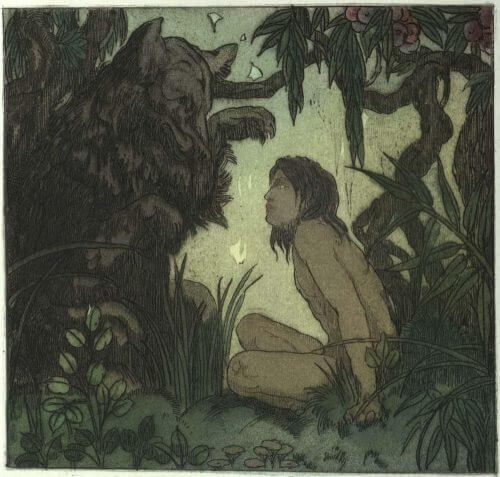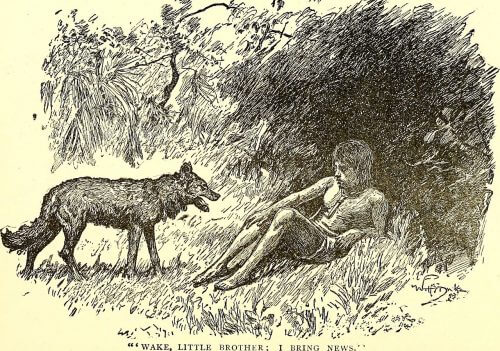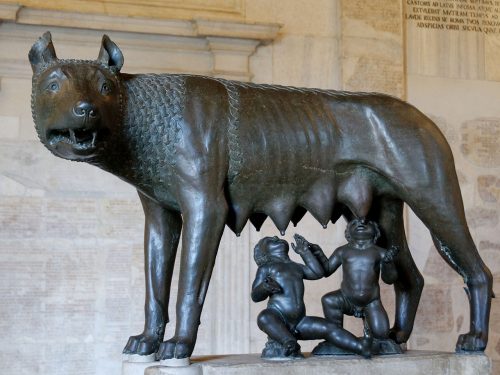Many myths, books and films unfold the stories of "wild children" - children who were adopted in their infancy by animals and got used to living only in the company of animals. It turns out that even in reality, children were discovered who were abandoned at a young age and raised with animals. How did they survive, what "animal" skills did they adopt and did they manage to integrate into human society?

Article: Human poem, Young Galileo
"Always look only for the good that is really necessary for the bear and forget the troubles in life", Balo the bear teaches Mowgli in the well-known movie based on Rudyard Kipling's book "The Jungle Book". The story takes place in the magical and wild rainforest in India, and describes the childhood of Mowgli, a boy who was adopted by a pack of wolves in the jungle, played with bears, elephants and panthers and fought heroically against Shirhan, the evil tiger.
Mowgli learns from the animals how to survive in the jungle, what to eat and how to behave like them, and they become the only family he knows. But the curiosity to see his own people in the villages reveals to him the fascinating and complicated world of humans. At the end of the movie Mowgli decides to follow the beautiful human daughter to the village and say goodbye to his friends, the animals in the jungle.
"It was inevitable," says Bagheera the panther to Baloo the bear sadly, "Mowgli is where he belongs." Balo sadly agrees: "Yes, you are right. And I still think he could have been a wonderful bear!”
live like the animals
Many cultural researchers, zoologists and psychologists have studied for years the integration of animals into the world of humans. Many of us raise domesticated animals, which behave differently from wild animals raised without the presence of humans. The domesticated animals (such as dogs and cats) learn human customs and adapt to life in human society.
There are completely different and fascinating cases of humans integrating into the company of animals. In recent centuries, some surprising and astonishing stories have been known about children adopted by animals, these children are called feral children, wild children or feral children.
Some of the children of the wild not only adapted to the wild environment they grew up in and adapted themselves to it, but also learned to think and communicate like the animals they grew up with. They learned body gestures, unique voices, facial expressions and communication signs from the rich world of wild animals, and assimilated into their non-human environment. In many ways, some of the physical characteristics of those children resembled those of the animals that adopted them more than those of humans, and they excelled in their ability to extract information from the environment and in sharp and developed senses (such as the sense of smell and hearing).
When people found feral children, they tried to bring them back into human society and "civilize" them. The children, who were used to living in nature with the animals, were displaced from their environment, hunted or imprisoned. Humans found unusual "animalistic" characteristics in those children, and usually used violent means against them to restrain them.
the wolf girl
One of the first stories is the story of a girl who was seen in 1845 in the Texas prairie accompanied by a pack of wolves. Residents who noticed her suspected that she was a baby who had disappeared a few years earlier, right after she was born, in one of the nearby farms.
A pregnant woman and her husband went for a walk before giving birth and ran into a severe storm. The birth got complicated, and the husband ran to call for help. When he returned, he found his wife lifeless - and the baby gone. Wolves tracks were seen around the place. No one knew what had become of the baby, and they assumed that the worst had happened.

About a decade later, residents testified that they saw in the distance a girl with long hair walking on all fours next to a pack of wolves. Every time she saw humans she got up on two legs and ran away. Local cowboys decided to look for her, and finally managed to capture her using a lasso (a rope with a loop at the end and used to catch horses), and she began to howl and growl.
One of the wolves heard the howl and came to help her, and the mornings shot him and killed him. They imprisoned the girl in a closed room on the farm, and at night the sounds of wolves were heard breaking into the farm. The cowboys arrived at the scene and shot them, but the girl managed to escape back into the wild. Since then they haven't found her; Many claim that this is a local legend.
the monkey boy
Another fascinating story about a wild child is the story of John Sebunya, who grew up with monkeys in Uganda in the early nineties of the last century. John ran away from his home at the age of two to the woods after his father murdered his mother and committed suicide. A group of monkeys adopted him and taught him to navigate the forests, climb trees and find food and water.
A woman who came to the area to collect wood for a fire was surprised to see that one of the monkeys had no tail, and realized that it was a child. John was taken to the nearby village; He resembled a monkey in appearance - he had fur on his body, his nails were long, and he did not know how to speak the language of humans. In the village he received medical treatment and human food, and this made him sick. He was eventually adopted by a British couple and taught him everything a child needs to know to live in the company of humans.
the children of the dogs
There are stories about boys and girls who grew up with dogs. Such, for example, is the story of Oksana, a girl from Australia whose drunken parents abandoned her outside their home on a farm at the age of three. She managed to get to a shed on the farm, where dogs took care of her and fed her for about five years.
In 1991 local residents found her running on all fours, barking and drinking with her tongue. The authorities put her in an institution, and in 2006, when she was 23, a British psychologist who examined her reported that although she spoke politely, mentally she remained a six-year-old girl.
In 2004, newspapers in Russia reported on the boy Andrei, who was abandoned at the age of three months in Siberia and a wild dog raised him and ensured his survival. Because of this he adopted the behaviors of a dog and used to sniff and bite humans. When he was found he was transferred to an orphanage, he showed fear of people and behaved aggressively. Psychologists could not predict whether he would succeed in adapting human behavior to himself in the future.
In 2009, a five-year-old feral girl was found in Russia living in a closed house with dogs and cats. The girl was dirty and small for her age and used to jump on the door and bark. The policemen who found her handed her over to welfare officials, who sent her to an orphanage.
Stories about feral children continue to be published. Recently, news was published about a ten-year-old girl who was found in the jungle in India and grew up with monkeys. The Indian police are still trying to find out the identity of the girl, who is being treated in an Indian hospital. Lumberjacks who found her said that she wandered naked in the jungle and felt comfortable in the company of monkeys.
The animal myth
The surprising stories of the abandoned children who manage to survive in the wild against all odds have stimulated the imagination of writers and creators for hundreds of years, the most famous of which are "The Jungle Book" and "Tarzan" (an English boy who was abandoned in an African jungle, was adopted by monkeys and became their leader), And also "Alone in the Wild Forest" by Yitzhak Bashavis-Zinger and "The Boy and the Bear" by Nurit Zarhi.

One of the earliest myths from Roman mythology is the story of Remus and Romulus, twin brothers who are credited with founding the city of Rome. The twins - the sons of Mars, the Roman god of war, and the king's daughter Silvia - were abandoned on the bank of the Tiber River in a basket. A thirsty she-wolf came to the river, found them and nursed them as if they were her sons, until a shepherd who passed by picked them up.
The two grew up to be strong and fearless and decided to found a new city, but could not decide which of them would rule it. Finally, Romulus murdered his brother Remus and became the ruler of the city, and it was named after him - Rome. Today you can see the famous statue of the wolf in the Capitoline Museum in Rome.
Mowgli syndrome
The phenomenon of feral children who usually imitate and adopt the behavior patterns of the animals they grew up with was nicknamed "Mowgli Syndrome", after the boy from "The Jungle Book". The term was coined by researcher Wendy Doniger from the University of Chicago, and it describes the connection of the world of concepts of nature with the world of human concepts as well as the child being a "human animal".
The syndrome is not considered a disease, but unlike Muggle or Tarzan, the real children of the wild had a very difficult time adapting to life in human society. As mentioned, some of them were thrown into closed institutions, and even died before they reached matriculation.
The assimilation of some of the wild children into the adopting "animal" environment was sometimes perfect, most of them were accepted by the animals without conditions and they adopted superhuman abilities. We cannot know for sure if all the stories really happened, but nevertheless we can learn from them about the rich world of animals, about their ability to accept the different, and not least: about the choice of humans to rule, domesticate and culture.
The article was published in Young Galileo - the monthly for curious children. For a gift digital sheet Click

2 תגובות
In this whole article I was missing one famous name
Tarzan by Edgar Rice Burroughs.
The most tragic detail in the discussed issue is the fact that children adopted by animals
And were "tainted" by them and adapted to themselves the behavior and language of the animals, never again
will be able to learn and adapt to human culture and language at an adequate level, and in fact
Ishro are retarded all their lives.